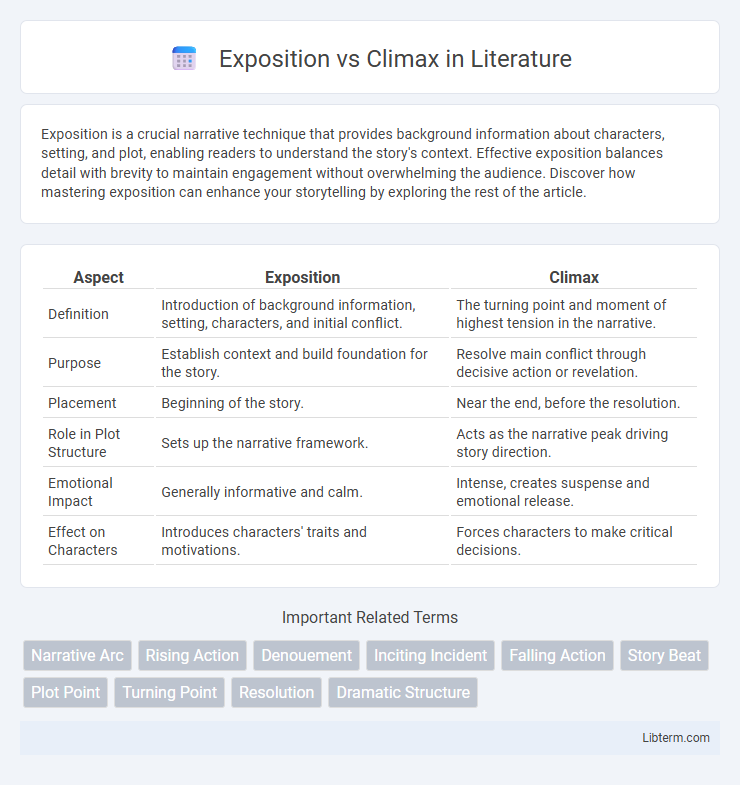Exposition is a crucial narrative technique that provides background information about characters, setting, and plot, enabling readers to understand the story's context. Effective exposition balances detail with brevity to maintain engagement without overwhelming the audience. Discover how mastering exposition can enhance your storytelling by exploring the rest of the article.
Table of Comparison
| Aspect | Exposition | Climax |
|---|---|---|
| Definition | Introduction of background information, setting, characters, and initial conflict. | The turning point and moment of highest tension in the narrative. |
| Purpose | Establish context and build foundation for the story. | Resolve main conflict through decisive action or revelation. |
| Placement | Beginning of the story. | Near the end, before the resolution. |
| Role in Plot Structure | Sets up the narrative framework. | Acts as the narrative peak driving story direction. |
| Emotional Impact | Generally informative and calm. | Intense, creates suspense and emotional release. |
| Effect on Characters | Introduces characters' traits and motivations. | Forces characters to make critical decisions. |
Understanding Exposition and Climax
Exposition establishes the foundation of a narrative by introducing characters, setting, and background information essential for understanding the plot. Climax represents the story's pivotal moment of highest tension or conflict, where key decisions and actions determine the resolution. Mastering the functions of exposition and climax enhances comprehension of narrative structure and the emotional impact on the audience.
Defining Key Story Elements
Exposition establishes the foundational context of a narrative by introducing characters, setting, and initial conflicts, which are essential for audience understanding. The climax represents the story's peak emotional and narrative tension where the main conflict reaches its turning point, driving the resolution. Understanding these key story elements enhances storytelling through clear structure and impactful progression.
The Role of Exposition in Storytelling
Exposition provides essential background information about characters, setting, and plot, helping audiences understand the narrative context before the climax intensifies the story. It establishes the foundation for conflict and character motivation, allowing emotional and thematic stakes to develop organically. Effective exposition balances clarity and engagement without overwhelming the story's pacing, ensuring readers remain invested through buildup to the climax.
The Purpose of the Climax
The climax serves as the pivotal moment of highest tension and conflict resolution in a narrative, driving the story toward its conclusion and revealing the protagonist's ultimate challenge. It functions to evoke strong emotional responses, solidify character development, and deliver the story's central message or theme. Unlike exposition, which introduces essential background information and setting, the climax intensifies the plot and determines the narrative's outcome.
Exposition vs Climax: Major Differences
Exposition and climax serve distinct roles in narrative structure, with exposition providing essential background information about characters, setting, and conflict to establish the story's foundation. The climax represents the peak of tension or turning point where the main conflict reaches its most intense moment, often determining the story's direction. Unlike exposition, which is typically passive and informative, the climax drives action and emotional engagement, making it the narrative's most critical and memorable event.
How Exposition Sets the Stage
Exposition establishes the foundational elements of a story by introducing key characters, settings, and conflicts, creating a framework for audience understanding. It provides essential background information that informs the narrative's direction and emotional stakes. This groundwork enables the climax to achieve maximum impact by fully engaging the audience with the story's developed context.
Building Tension Towards the Climax
Exposition establishes the setting, characters, and initial conflicts, laying the groundwork for escalating tension by introducing stakes and uncertainties. As the narrative progresses, pacing intensifies and obstacles multiply, driving emotional investment and anticipation. This crescendo of tension reaches its peak in the climax, where conflicts confront resolution and narrative energy culminates.
Common Mistakes in Exposition and Climax
Common mistakes in exposition include overloading the narrative with excessive background details that overwhelm readers and slow pacing, while underdeveloped exposition can leave essential story elements unclear. In climax, frequent errors involve reducing tension too early or stretching the scene unnecessarily, which diminishes impact and fails to deliver emotional payoff. Balancing exposition and climax ensures coherent storytelling that maintains reader engagement and provides a satisfying resolution.
Examples of Effective Exposition and Climax
Effective exposition in storytelling clearly establishes the setting, characters, and conflict early on, as seen in *Harry Potter and the Sorcerer's Stone*, where the magical world is introduced through relatable everyday life details. The climax, exemplified by the intense duel between Harry and Voldemort in *Harry Potter and the Goblet of Fire*, delivers peak tension and decisive action that resolves the central conflict. Both elements work cohesively, with exposition setting up stakes and climax providing emotional payoff, enhancing overall narrative impact.
Mastering Exposition and Climax for Stronger Narratives
Mastering exposition involves delivering essential background information concisely to build context without overwhelming the audience, setting the stage for the narrative's progression. The climax represents the story's turning point where conflict reaches its highest intensity, demanding precise pacing and emotional impact to resonate deeply with readers. Balancing clear exposition with a compelling climax enhances narrative tension and keeps audiences fully engaged throughout the storyline.
Exposition Infographic

 libterm.com
libterm.com